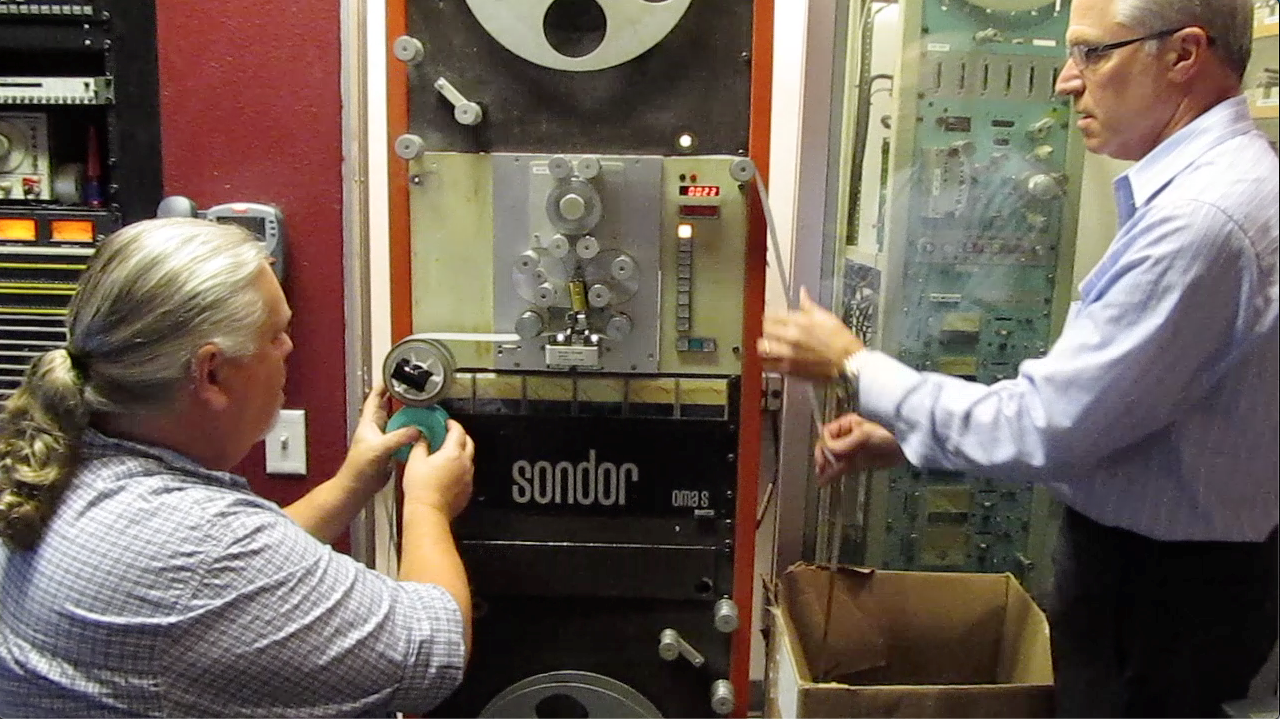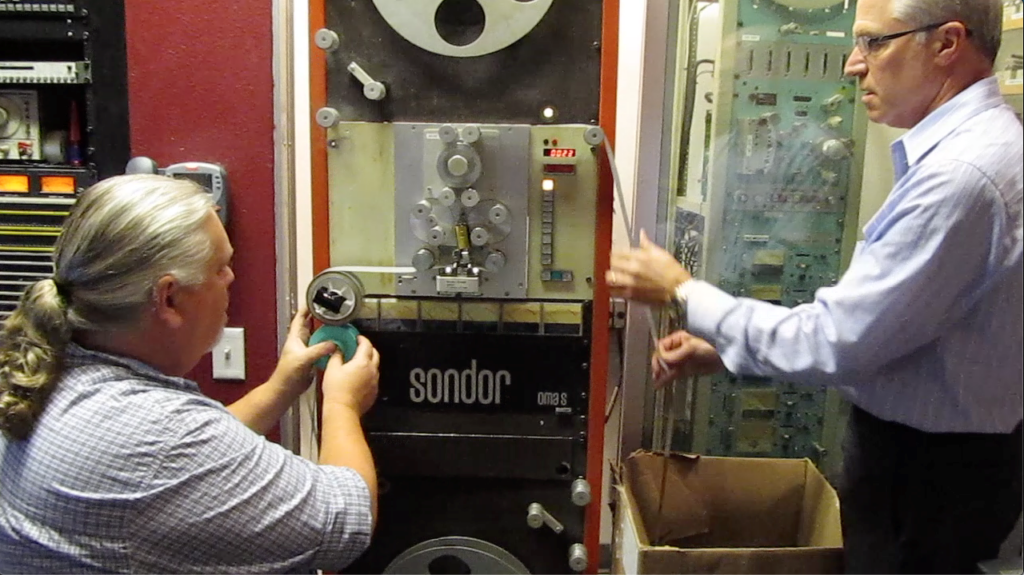
How to Preserve
The Legacy of Chace Audio: An Archivist’s Perspective
By Alejandra Espasande Bouza
Dedicated to the unsung heroes of audio preservation and restoration
Film preparation work bench with brittle and warped “Clear Edge” 35mm magnetic film
Chace Audio
My first job after graduating from the UCLA Moving Image Archive Studies program was at Chace Audio, a world-renowned post-production house that serviced Hollywood studios and film archives around the world. In those days Chace was located in Burbank, and its well-oiled operation was run by an army of client reps, film technicians, transfer engineers, sound restorationists, and audio mixers. Fresh out of University, I was happy to find an untapped source of technical knowledge imparted by the sound engineers who unassumingly labored behind the scenes. In that ecosystem of sound, I would spend three of the most formative years of my life.
I joined the Element Preparation Services department, located in a “clean room” environment with strict PPE protocols, furnished with film benches and all the tools and equipment necessary to inspect and prepare elements for digitization. These included original recordings of Academy Award winning films, and represented the gamut of 20th century technology: ranging from optical soundtrack negatives to multi-track magnetic film formats, audiotapes, and recordings made on vitaphone discs and spools of wire.
Fused film reel “AKA Hockey puck” pulled from rusted Goldberg reel
The Art of Film Preparation
On occasion, the company’s President, Bob Heiber, would pop in with a film recording in an advanced state of decomposition. These were exciting challenges and the stakes were high, for failure could mean the loss of important content. After careful evaluation, we would devise a strategy to ensure that the element would survive the machine’s transport while providing the best possible audio capture.
Since assets like film move from the physical to the digital realm, the quality of their preparation, combined with the expertise of the transfer engineer, are key to obtaining the best possible raw transfers. A badly prepared/transferred element can contribute to a more challenging restoration experience, if not a lower quality digital surrogate that will live on when the physical asset is gone.
Hydration Techniques
A majority of the affected elements were 35mm magnetic film recordings that experienced “vinegar syndrome”: a chemical reaction that affects acetate film (aka hydrolysis). An element with this type of decay could be so brittle that it would crack; the iron oxide embedded in the emulsion would shed; and a white paste-like substance called plasticizer would cover the entire emulsion surface. We took many precautions to protect our eyes, lungs and skin when handling such elements. If you were to walk in on any given day, you would find the ICU of frail films!
Rick Chace operating a sound mix console. To watch a video interview, click
The most challenging scenario was a reel film fused into a “hockey puck,” as they would call it. In these instances, we would apply hydration to capture the film’s last breath. These techniques were developed and taught by Thom Piper, an avid horseman with a cowboy-like personality who hailed from a family of sound engineers that included his grandfather, the cymbal player in Alfred Hitchcock's gripping scene from The Man Who Knew Too Much (1956). We had a high success rate, and later on in my career I would remind my colleagues not to give up easily on an element, no matter how bad it looked. In the hands of specialized film technicians and transfer engineers anything is possible.
Frederick Irving “Rick” Chace (1947-1992)
For the company it was important to document and update all processes with detailed guidelines and training manuals, which set the standard for efficiency and quality work. These principles were originally established by its founder, Rick Chace, a pioneering sound engineer who championed the ethics of audio preservation and restoration; created systems like Chace Surround Stereo; and developed the Comtrack technology (aka Chace Optical Soundtrack Processor) for the imaging of negative film elements still used to this day.
Rick, who passed away in 1992, left an undeniable imprint on the company culture and his presence was felt through the anecdotes shared by those who worked with him. From my colleagues' recollections, Rick had been a disciplined perfectionist. Whenever I set foot in the Rick Chace Studio, the largest of our many recording spaces, I would reflect on the tragedy of such an untimely death, and wondered how much more he could have contributed to the field.
One day when I was tasked with making room in a storage area, I found a box full of books that had belonged to Rick. As I perused them, I was surprised to find Autobiography of a Yogi, a book revered by my family that chronicles the spiritual journey of Paramahansa Yogananda (1893-1952), an Indian yogi who settled in Los Angeles in the 1920s, bringing with him the practice of “Kriya Yoga” through the establishment of Self Realization Fellowship. In his teachings, Yogananda advocates for inner balance and ethical behavior as fundamental for any type of success. This discovery made me feel closer to Rick. It dawned on me that behind the stern maverick there was room for spiritual curiosity. Perhaps that balance helped propel the meteoric success of the company which outlived him. Years later, I learned that when confronting his untimely death, Steve Jobs requested this book distributed to all those who attended his funeral.
The Legacy
Bob Heiber continued Rick’s legacy, ensuring that everyone was properly trained and understood the ethics of our field. In addition, through the Rick Chace Foundation – established in 2002– he has contributed greatly to bringing awareness to the history, art and technology of motion picture sound. Through the foundation, he has provided scholarships to up-and-coming Moving Image Archivists; and in collaboration with film restorationist Bob Gitt, produced A Century of Sound, an unparalleled educational video on the history of sound technology.
After three years at Chace, my long journey came to an end. It was long, full of adventure, and full of knowledge. In retrospect, I’ve come to realize the importance of documenting these rapidly disappearing spaces, whose technicians, seldom credited for their work, are so integral to the preservation of our moving image and sound archives.

Audio Engineer Joe Edwards (left) and Chace Audio President Robert Heiber (right) transferring by hand a very brittle clear edge magnetic film element
Highlights from the 2015 Academy Visual History interview conducted with Bob Heiber, former President of Chace Audio.
Robert “Bob” Heiber biography
A graduate of Purdue University, Robert (Bob) Heiber began his career in 1973 as a 16mm industrial filmmaker in Chicago, Illinois. In 1979 Bob joined Warner Bros. in studio operations prior to becoming the General Manager of Chace Productions in 1990. In 1992, he became the president of the company and continued on in the role of Vice President of Audio Preservation and Restoration after Chace was acquired by Deluxe Media in 2009 and retired in 2014. A frequent speaker at conferences and seminars worldwide, Bob has also served as a committee member or chair for six national panels for the Library of Congress on sound preservation and restoration. A member of AMIA since 1991, he was awarded the association's Silver Light Award for career achievement in 2014. In 1999 he became a member of The Academy of Motion Picture Arts and Sciences.
Recommended resources:
- The Rick Chace Foundation
http://trcf.org - Rick Chace describes CSS™
https://www.youtube.com/watch?v=N_aKHkooi-4 - FilmCare.org
https://filmcare.org/vd_plasticizer_exudation.php - Oral Histories from 1948: Paper Tape to Bits and Bytes
https://theacademy.tumblr.com/post/99348455121/oral-histories-from-1948-paper-tape-to-bits-and - The Deadly Crescendo - "The Man Who Knew Too Much" | Hitchcock Presents
https://www.youtube.com/watch?v=1CBjxGdgC1w


Rick Chace was a really wonderful, knowledgeable guy who was not only passionately committed to sound restoration, he was also a dedicated movie fan and a serious music collector as well. I considered him a good friend in the 1980s and was glad for his success at restoring so many important films during his lifetime. Everything I know about optical sound came from Rick – he knew all the ins and outs about ancient audio formats. His death was a tremendous loss, but I know he’d be pleased that he’s remembered and organizations like the Academy’s Digital Preservation group is keeping the dream alive.